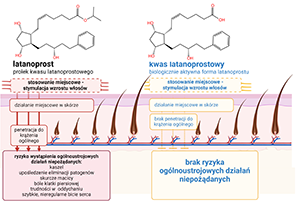Will a glaucoma drug revolutionize the treatment of androgenetic alopecia? On drug repurposing, when the side effect becomes a desired therapeutic outcome.
DOI:
https://doi.org/10.18388/pb.2021_577Abstract
Prostaglandins are hormones found in almost all mammalian tissues. As signaling molecules, they play a key role in the regulation of many physiological processes, including hair growth cycle. The article describes the history of the discovery of prostaglandins, including the work of Professor Ryszard Gryglewski – the discoverer of prostacyclin. Particular attention was paid to the synthetic analogue of prostaglandin F2α - latanoprost. Indicated for the treatment of glaucoma, the drug is known for inducing eyelash growth as a side effect. A prodrug, latanoprost
is converted to its active metabolite, latanoprost acid. Recent research demonstrated that latanoprost acid has a chance to become an effective alternative to minoxidil and finasteride - the only drugs currently registered for the treatment of androgenetic alopecia. The development of
anti-alopecia drugs containing prostaglandin derivatives, including latanoprost acid, will be a much faster process compared to the traditional path of product development based on a new chemical compound.

Published
Issue
Section
License
Copyright (c) 2024 Kalina Spławska, Łukasz Zybaczyński, Maciej Wierzbicki, Katarzyna Koziak

This work is licensed under a Creative Commons Attribution 4.0 International License.
All journal contents are distributed under the Creative Commons Attribution-ShareAlike 4.0 International (CC BY-SA 4.0) license. Everybody may use the content following terms: Attribution — You must give appropriate credit, provide a link to the license, and indicate if changes were made, ShareAlike — If you remix, transform, or build upon the material, you must distribute your contributions under the same license as the original. There are no additional restrictions — You may not apply legal terms or technological measures that legally restrict others from doing anything the license permits.
Copyright for all published papers © stays with the authors.
Copyright for the journal: © Polish Biochemical Society.



